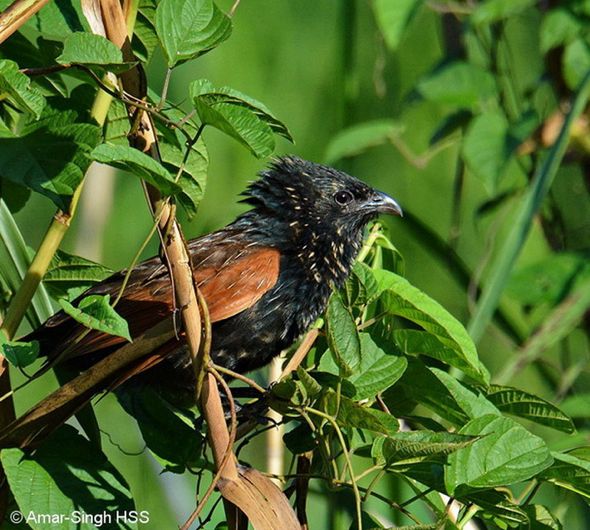
Minyak burong butbut (Crow Pheasant oil) is available in the Indo-Malayan region. It is used to treat burns, fractures, sprains, etc. – see this Link.
Burong Butbut is the Malay name for the Crow Pheasant, now known as coucal (Centropus sp.). The Greater Coucal (C. sinensis) is known as Butbut Besar while the Lesser Coucal (C. bengalensis), Butbut Kecil. The former is an uncommon resident while the latter is common. Both species are widespread throughout Asia, from India to south China, Nepal and Indonesia. The birds make their deep cup nests with a dome in dense vegetation. The entrance is at the side.
According to Wikipedia, the coucal is associated with numerous superstitious beliefs.

Oil made from the coucal chicks is used to treat burns, heat, fractures, sprains, etc. According to Madoc (1956): “There is a native belief that Crow Pheasant nestlings can be made into an emulsion that will cure all leg-troubles – even a broken leg. Those seeking these healing powers treat the unfortunate youngsters very cruelly, before boiling nestlings, nest and all in coconut oil in order to make the emulsion.”
According to this LINK, the Chinese in Borneo used to seek out the coucal nest. If the chicks were young they would break the leg of each chick. The adult hen would then gather herbs and feed them to the chicks whose legs would quickly heal. A second round of leg breaking would follow with the hen foraging for herbs and feeding them to the chicks. Once the chick’s legs were again healed, the harvester would come and collect them, putting them into wine. The tribal theory was that the chicks were now full of health-giving herbs evidenced by their rapid healing.
Such grandmother’s tale associated with these birds no doubt result in widespread poaching by the gullible.
Since the Middle Ages in Europe, the Doctrine of Signatures guided people to associate plants with their curative properties. This doctrine claimed that God inserted clues in plants and animals that allowed humans to discover their curative properties. In other cultures this principal similarly guided people to select their herbal plants. Thus the rugged surface of the walnut has curative properties for mental illness and migrane headache; the kidney shaped beans for urinary problems; tendrils to expel intestinal worms; casuarina needles for joint pains and so on and so forth.
In the case of minyak burong butbut, the myth had been distorted in claiming that the herbs brought by the adult birds could cure the fractured legs of the nestling.
Anyway, at least one Minyak Burong Butbut commercial that is found in the internet gives the oil makeup as: Kaempferia galangal (yellow ginger, galangar), Melaleuca lecodendron (now M. cajuputi (tee tree, gelam or kayu utih), Cocos nucifera oil (coconut) and Tinospora crispa.
Hopefully most, if not all the oil in the market are currently made from herbs and that there is no necessity of mutilating the chicks to include them in the production of the oil.
Feedbacks on whether the barbaric practice is still going on is appreciated.
Wang Luan Keng, who initiated the topic
Singapore
September 2016
Dato’ Dr Amar-Singh HSS
Ipoh, Malaysia, who provided extensive links
Daisy O’Neil
Penang, Malaysia, who supplied background information
Reference:
Madoc, G. C. (1956). An introduction to Malayan birds. Malayan Nature Society, Kuala Lumpur. (revised ed.) 234 pp.









4 Responses
On the subject of Coucals, they were not uncommon, even in suburban areas in Singapore, until about ten years ago. Since then, they appear to have totally disappeared.
I don’t think that poaching is an issue, since most poaching in Singapore is of songbirds. But, as the Coucals feed on small invertebrates and vertebrates, has the constant fumigation and grass cutting in this country eliminated their food sources?
After all, I have not seen any skinks in my garden for years, and the population of Calotes lizards is now greatly reduced.
Saw quite a number today Chiu San in my urban neighborhood in Ipoh. I agree with you, Singapore has become pristine and this has affected food sources for some birds. I even saw Mynas feeding on nectar in Singapore during a visit.
In India peacock oil is considered as a cure for arthritis and the birds which are considered endangered are poached for this purpose. A consignment of peacock oil which was meant for export to Malaysia was seized in Chennai a few years ago. Emu (imported from Australia) farming was quite popular in South India a few years ago for its meat and oil which is held in great esteem as a cure for rheumatism, but the industry collapsed due to non availability of processing units. Thankfully the use of birds in preparation of indigenous medicine in relatively less in India. What is the situation in SE Asia?
Thanks for the info on peacock oil. No idea re use of birds and their parts in SEAsia. Anyone has info?